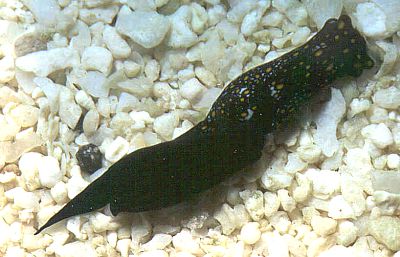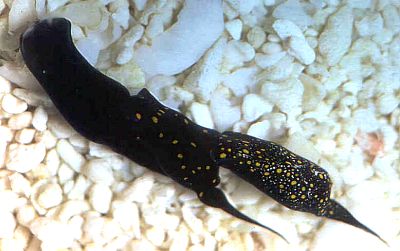Chel. sandrana & C. tsurugensis mating
March 29, 2001
From: Lindsay Warren


Dear Bill
I thought you might be interested in the attached photo of Chelidonura sandrana and C. tsurugensis mating. The almost black specimen does in fact have 3 dark orange but rather inconspicuous spots which are hard to see in the scan. After cavorting around for a while in this mating formation they then swopped around so that the almost black specimen mated with C. sandrana. I found them at 7am on 15 October 2000 at low tide in about 3 inches of water on the sand and seagrass flats of Pulau Hoga, Tukang Besi Archipelago, SE. Sulawesi. Size range: 12-15 mm. [Operation Wallacea]
Some time ago I sent you photos of other specimens of C. sandrana / C.
tsurugensis and commented about observing them mating but did not have any photos of this. I have checked through the list of preserved specimens and these have all been kept in separate jars so it would be possible to check them individually.
All the best
Lindsay Warren
alldcl@compuserve.com
Warren, L., 2001 (Mar 29) Chel. sandrana & C. tsurugensis mating. [Message in] Sea Slug Forum. Australian Museum, Sydney. Available from http://www.seaslugforum.net/find/4056Dear Lindsay,
Thanks for the great photos. I have no problem with Chelidonura sandrana ranging in colour from its full floral pattern to pure black. The problem is to determine whether Chelidonura tsurugensis is the same species. As you will see from earlier correspondence it would be nice to know a little more about the colour range and the anatomy of 'typical' C. tsurugensis from Japan.
The problem is that 'lumping' or synonymising two species into one is a more difficult task than describing a new species. If I lump C. sandrana and C. tsurugensis together now and later find that its anatomy is different, then it will be more confusing than leaving them separate for a little while longer. At present 'C. sandrana' exhibits its wide colour variety throughout its wide geographic range while 'C. tsurugensis' seems to only have the yellow-spotted colour pattern in Japan. if they are both the same species I would expect that the full range of colour variation, or at east part of it, would be exhibited by Japanese specimens. Hopefully someone from Japan will be able to give us some more colour information, if not specimens.
Best wishes,
Bill Rudman.
Related messages
-
Larvae of Chelidonura sandrana
From: Johannes Faber, November 20, 2006 -
Colour form of Chelidonura sandrana
From: Gillian Elliott, March 11, 2003 -
Chelidonura sandrana colour morphs
From: Nils Anthes, January 25, 2003 -
Re: Chelidonura sandrana - feeding
From: Nils Anthes , January 18, 2003 -
Chelidonura sandrana - feeding in lab
From: Nils Anthes, January 15, 2003 -
Re: Chelidonura? from the Philippines
From: Erwin Koehler, December 3, 2002 -
Chelidonura? from the Philippines
From: Erwin Koehler, December 2, 2002 -
Re: Chelidonura sandrana complex
From: Terry Gosliner, February 9, 2000 -
Chelidonura sandrana & look-alikes
From: Lindsay Warren, February 5, 2000
